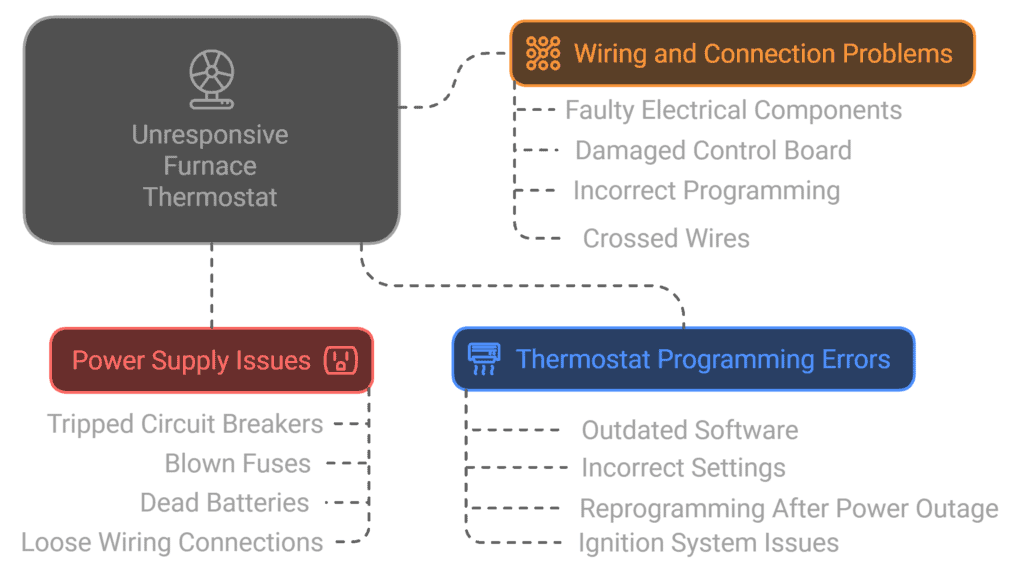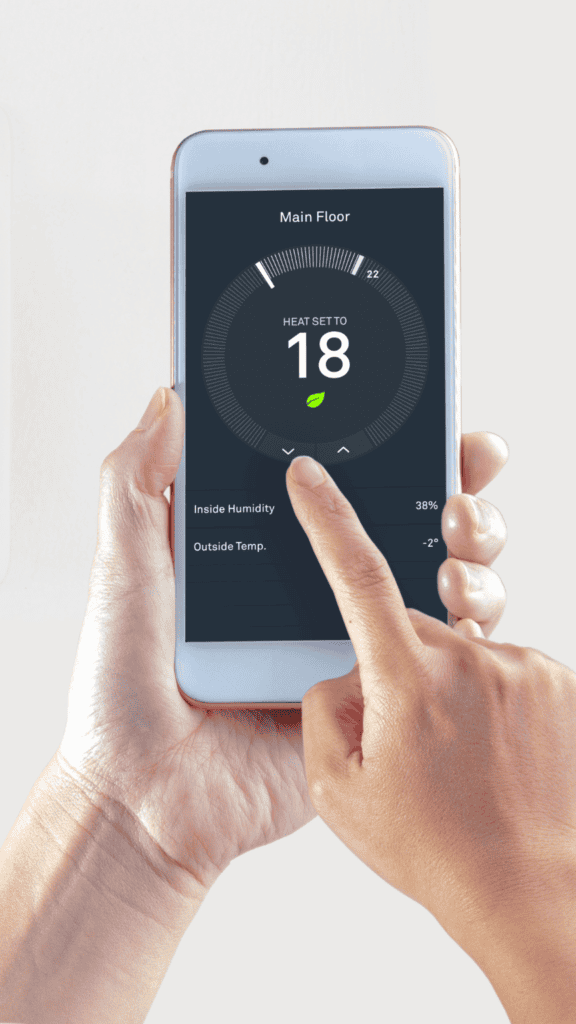If your furnace thermostat won’t turn on, start by checking the power supply. Look for dead batteries, tripped circuit breakers, or blown fuses. Next, inspect the wiring for loose connections or damage. Verify that the thermostat’s settings are correct and try resetting it. Clean any dust or debris that might interfere with its operation.
If these steps don’t work, there could be an issue with your furnace’s ignition system or other components. For smart thermostats, ensure they’re compatible with your HVAC system and properly connected to Wi-Fi.
If problems persist, it’s time to call a professional. The following guide offers more in-depth solutions and preventive measures.
Key Takeaways
- Check power supply issues, including dead batteries or tripped circuit breakers.
- Inspect for loose wiring connections or damaged wires affecting thermostat function.
- Verify thermostat programming settings are correct and properly configured.
- Examine furnace components for visible issues that may impact thermostat operation.
- Test voltages, reset the thermostat, or install new batteries if necessary.
Common Causes of Unresponsive Furnace Thermostats

When your furnace thermostat isn’t responding, you’ll want to check a few key areas. Start by examining the power supply, as dead batteries or tripped circuit breakers can cause issues.
For more complex problems, certified HVAC technicians can provide a thorough diagnosis and repair. Next, look for loose wiring connections or damaged wires, and finally, verify that your thermostat’s programming settings are correct.
Power Supply Issues
Power supply problems are often the root cause of unresponsive furnace thermostats. Check for tripped circuit breakers or blown fuses in your home’s electrical panel.
If your thermostat uses batteries, replace them with fresh ones. Inspect the wiring between the thermostat and furnace for any loose connections. Verify the power supply to your furnace is on and functioning properly.
These simple checks can often resolve the issue of a thermostat not turning on heat.
Wiring and Connection Problems
Wiring and connection problems are another common culprit behind unresponsive furnace thermostats. Faulty electrical components, like loose wiring connections or a damaged control board, can disrupt communication between your thermostat and the furnace.
Incorrect thermostat programming or settings may also cause issues. Crossed wires, corroded terminals, or incompatible thermostats can lead to malfunctions. If you’re unsure, it’s best to have a professional HVAC technician check your system’s wiring, sensors, and relays.
Thermostat Programming Errors
Thermostat programming errors are a frequent source of furnace unresponsiveness. You might experience thermostat failure due to outdated software or incorrect furnace settings.
After a power outage, battery-operated thermostats may need reprogramming. Hardwired models can also malfunction. To troubleshoot, check your thermostat’s settings and update its software if possible. Don’t forget to inspect the furnace’s ignition system, as it can cause similar issues.
Troubleshooting Steps for Non-Functioning Thermostats
When your furnace thermostat isn’t working, start by checking its power sources and electrical connections. Ensure the circuit breaker is on and check for any blown fuses that may be affecting the thermostat’s power supply.
Next, inspect the thermostat’s settings and configurations to validate they’re correct. Finally, examine the furnace components for any visible issues that might be affecting the thermostat’s function.
Checking Power Sources and Electrical Connections
For a non-functioning thermostat, checking the power sources and electrical connections is a vital step. If your thermostat’s unresponsive, it might be due to faulty wiring or a dead battery. Inspect the circuit board for signs of damage.
Diagnose the electrical system by testing voltages. Try to reset the thermostat or install new batteries. Check thermostat settings to ensure they’re correct. If problems persist, consult a professional to fix a thermostat that won’t turn on.
Inspecting Thermostat Settings and Configurations
After checking power sources and connections, the next pivotal step in troubleshooting a non-functioning thermostat is inspecting its settings and configurations. Ensure the furnace switch is on and the temperature regulator is set correctly.
For Wi-Fi-enabled models, verify the connection. Examine HVAC setpoints and calibration. Reset the thermostat if needed. These steps often resolve common issues when a thermostat is not turning on the furnace.
Examining Furnace Components
If your thermostat still isn’t working after checking its settings and configurations, it’s time to examine the furnace components.
Look for signs of furnace malfunction, such as pilot light problems or dirty internal components. Check for a faulty heat exchanger, malfunctioning blower motor, or clogged burners. Inspect the gas valve for defects and ensure the limit switch isn’t worn out. These issues can prevent your thermostat from functioning properly and may be why your thermostat won’t turn on furnace.
Smart Thermostat Solutions for Enhanced Reliability

Smart thermostats offer a range of features that can boost your heating system’s reliability and efficiency. You’ll find options with Wi-Fi connectivity, learning capabilities, and integrated sensors to monitor various environmental factors.
Professional installation of smart thermostats ensures optimal performance and integration with your existing HVAC system, contributing to increased energy efficiency and system longevity. Before upgrading, check your current HVAC system’s compatibility and consider professional installation to ensure proper setup and maximum benefits.
Features of Modern Smart Thermostats
Modern smart thermostats often offer a range of features that enhance reliability and energy efficiency in your home heating system. Popular brands like Nest Learning Thermostat, Honeywell, and Ecobee thermostats are Wi-Fi-connected, allowing remote access and control through mobile apps.
They offer smart scheduling, and learning your habits to optimize heating. Many also support voice control, making adjustments even easier. These features help you save energy and maintain comfort effortlessly, even if your thermostat stopped working previously.
Installation and Setup Considerations
While smart thermostats offer impressive features, their effectiveness hinges on proper installation and setup. Ensure your new climate controller is compatible with your HVAC system.
Whether you’re installing Emerson or Carrier thermostats, proper placement is crucial for accurate temperature control. Consider consulting an HVAC technician for professional installation.
Regular furnace maintenance, including thermostat updates, is essential for optimal heating control. Invest in a smart thermostat for enhanced reliability and energy savings.
Compatibility with Existing HVAC Systems
Upgrading to a smart thermostat can boost your home’s energy efficiency, but it’s vital to verify compatibility with your existing HVAC system first. Your new heating gauge must match your furnace’s capabilities, including multi-stage heating and heat pump systems.
Improper installation or neglected maintenance can lead to accidental shutoff. Consult an HVAC pro to ensure proper integration and system performance monitoring. Don’t risk thermostat malfunctions or furnace problems due to mismatched components.
Professional Diagnosis and Repair Options
If you’ve tried basic troubleshooting and your furnace thermostat still isn’t working properly, it’s time to call an HVAC technician. Professional repair procedures often involve detailed system diagnostics, component replacements, and precise calibrations to restore optimal performance.
Licensed technicians are trained to follow safety regulations and manufacturer guidelines, ensuring that your heating system operates efficiently and safely when considering thermostat replacement, factor in both the cost of the new unit and the professional installation, which can vary based on the complexity of your heating system.
When to Call an HVAC Technician
Most furnace thermostat issues can be resolved with basic troubleshooting, but there are times when you’ll need to call in a professional HVAC technician. Consider contacting an expert when:
- Your smart thermostat’s error code display is confusing
- Wireless connectivity problems persist
- You can’t program maintenance reminders or filter change alerts
- The thermostat isn’t improving HVAC efficiency as expected
- You’re unsure how to set up efficiency tracking features
A technician can ensure your thermostat is properly installed and functioning efficiently, especially if you’re wondering who can fix a thermostat that’s not working.
Common Professional Repair Procedures
When you call in a professional HVAC technician, they’ll typically start with a thorough inspection of your furnace and thermostat system. They’ll check for blocked air filters, issues with the blower motor, and compressor problems.
For dual fuel systems or zoned HVAC systems, they’ll ensure proper communication. Technicians can also address advanced features like occupancy sensing, energy usage reports, and integration with smart home systems to optimize your heating system’s performance and fix issues like heat not turning on.
Cost Considerations for Thermostat Replacement
While considering a thermostat replacement, you’ll need to factor in various costs associated with professional diagnosis and repair. The price can vary based on several factors:
- Technician’s hourly rate
- Complexity of your heating system
- Type of thermostat (basic vs. smart)
- Potential issues with the heat exchanger or cycling
- Additional work required for energy savings
Consider thermostats with intuitive controls and on-device menu navigation for easy temperature adjustments in degrees Celsius or Fahrenheit. Remember, a new thermostat can improve your system’s efficiency in BTUs.
Preventive Maintenance to Avoid Future Thermostat Issues
To keep your furnace thermostat working smoothly, you’ll need to adopt some preventive habits. Start by setting up regular cleaning and inspection routines for your thermostat and surrounding area.
Regular inspections of your entire heating system, including the thermostat, can help prevent costly repairs and maintain optimal performance. Don’t forget to check for software updates recalibrate your thermostat as needed, and schedule seasonal HVAC system tune-ups to catch any potential issues early.
Regular Cleaning and Inspection Routines
Implementing a regular cleaning and inspection routine for your furnace and thermostat is key to preventing future issues and ensuring optimal performance. Perform monthly checks, clean components, and replace air filters regularly. Keep a maintenance log to track servicing dates.
- Wiping dust off a solar-powered thermostat
- Checking batteries in a dual-powered unit
- Cleaning a backlit display
- Testing Bluetooth connectivity
- Verifying Z-Wave, Zigbee, or HomeKit compatibility
These steps, along with 7-day programming, ensure your thermostat runs smoothly and prevent issues like your thermostat not turning on heat.
Software Updates and Calibration Checks
Three key preventive maintenance steps can help you avoid future thermostat issues: software updates, calibration checks, and regular programming reviews.
Keep your thermostat’s software up-to-date to ensure optimal performance of features like LED or e-ink displays, 5-2 day programming, and temperature presets. Regularly calibrate sensors for accurate readings of temperature, humidity, and air quality.
Review your settings through the web portal access, adjusting customizable display options as needed. Schedule annual professional inspections to catch potential problems early.
Seasonal HVAC System Tune-ups
Seasonal HVAC system tune-ups play an equally important role in preventing future thermostat issues. Annual maintenance helps identify potential problems before they cause malfunctions.
Schedule tune-ups in the fall to avoid emergencies during cold weather. Professional technicians perform thorough inspections and recommend timely repairs.
- Cleaning dusty air filters
- Calibrating thermostat settings
- Checking electrical connections
- Testing safety controls
- Maximizing system performance
These tune-ups improve energy efficiency and extend your HVAC system’s lifespan. They also ensure your smart thermostat’s features like geofencing, weather responsiveness, and voice assistant integration work seamlessly with your furnace for optimal thermal comfort.















